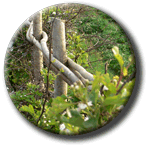Naturenet: How to survey a hedge according to the 1997 Regulations
How to survey a hedge according to the 1997 Regulations
By Alina Congreve
 This brief guide should help people with little or no experience
of using the Hedgerow Regulations 1997 to survey hedgerows. Some experience
of field botany, especially common trees and shrubs would be a help. You may
also find it easier if you are a beginner to survey outside the winter months.
The Regulations provide legal protection for only those hedgerows that meet
their criteria. Start off by walking along the whole length of the hedge, checking
there are no large gaps. If there are gaps larger than 20m then you will need
to survey it as two or more separate hedges. No real guidance is given about
what constitutes a hedge and you will have to make your own judgments. When
does a hedge become so gappy it is reduced to a line of trees? In the case
of my own survey work, a level of 35% gaps was chosen. Hedge volume is also
important. When does a hedge become so short it is not a hedge? In this study
a cut off point of less than 1m tall was chosen.
This brief guide should help people with little or no experience
of using the Hedgerow Regulations 1997 to survey hedgerows. Some experience
of field botany, especially common trees and shrubs would be a help. You may
also find it easier if you are a beginner to survey outside the winter months.
The Regulations provide legal protection for only those hedgerows that meet
their criteria. Start off by walking along the whole length of the hedge, checking
there are no large gaps. If there are gaps larger than 20m then you will need
to survey it as two or more separate hedges. No real guidance is given about
what constitutes a hedge and you will have to make your own judgments. When
does a hedge become so gappy it is reduced to a line of trees? In the case
of my own survey work, a level of 35% gaps was chosen. Hedge volume is also
important. When does a hedge become so short it is not a hedge? In this study
a cut off point of less than 1m tall was chosen.
Secondly calculate the length of the hedge. With shorter hedges this is best
done with a tape measure. With longer hedges it can be calculated with an
OS map. If the hedge is 30m or less in length then survey the whole hedge.
If the hedge is between 30-100m then survey the central 30m. If the hedge
is between 100-200m long then divide it in two and survey the central 30m
of the two sections. If the hedge is over 200m divide it in to three sections
and survey the central 30m of each of the thirds. The width of each of these
quadrats is the width of the hedge. It is usually possible to survey a hedge
from one side except in the cases of the highest and thickest hedges.
Once you have found the correct sections to survey you then need to identify
the woody species present. The most important criteria determining whether
a hedge will meet the Regulations is the number of woody species. These are
listed on Schedule 3 of the Hedgerow Regulations. Some of the species listed,
such as wild cotoneaster and downy current are very rare and you are unlikely
to ever encounter these in the field. Only those species listed on the Schedule
count. Currently trees like sycamore will not add to the score. Neither will
garden plantings lilac or fuchsia. Recent planting is also disqualified,
those that are less than 30 years old. This can often be difficult to determine
in the field.
The Regulations do not give any guidance on how to survey the herb layer. In
this case the quadrat used was the same size as for the woody vegetation.
It would also be possible to use a smaller quadrat of 10m long times the
width of the hedge. Values on this table are given in percentages. Sometime
these are less than 100% in total due to heavy grazing pressure. Recording
all species and abundance is not necessary for the Regulations but it is
an important component of other survey methods.
All the other features require you to survey the whole hedge.
- Standard trees – there is no mention that a
standard tree must also be a woody species so in this case you could count
a sycamore or domestic apple for example. To qualify as a standard tree
for a single stemmed tree the whole stem has to have a diameter of 20cm
or more at 1.3m from the ground. For multi-stemmed trees it must have at
least two stems over 15cm diameter at 1.3m from the ground.
- Record if there are any rare trees in the whole length of
the hedge. According to the Regulations a rare tree is a black poplar, large-leafed
lime, small-leafed lime, and wild service tree.
- A hedge gains extra points if it connects to another
hedge. Count all the other hedges that join the one you are surveying.
A connection is when the feature actually touches the hedge you are surveying
or would touch if the hedge continued in a straight line for up to 10m.
The same ‘10m in
a straight line’ also applies to pond and wood connections discussed
later.
- Does the hedge run parallel to a footpath
 , bridleway
, bridleway or BOAT
or BOAT (but not necessarily
a normal adopted vehicular highway unless it also is one of these)
(but not necessarily
a normal adopted vehicular highway unless it also is one of these)
- Is there a hedge that runs parallel within 15m? This does not apply to
hedges that are parallel to footpaths, bridleways or byways open to all traffic.
- Does the hedge connect to one or more woodlands composed of 50% or more
broad leafed trees? You will also need to make your own judgments about the
additional features listed in the Regulations such as ponds and woods. When
does a wood qualify as a wood and when is it only a group of trees? No guidance
is given on this matter in the Regulations. When the Department of the Environment
carried out a study about the Regulations they used the guidelines in the
Phase 1 Handbook but there is no legal reason why you need to.
- Does the hedge connect to any ponds? When does a pond qualify as a pond.
This is a particular problem in chalk areas where a pond may not have water
in all year round.
- Record the percentage of gaps in the hedgerow. It is not clear whether
gaps filled with species not occurring on the woody species list for example
bramble or sycamore count as gaps.
- Record if the hedge has a wall or bank along half or more of its length.
- Record if the hedge has a ditch along half or more of its length. This
can include ancient features as well as those of more recent agricultural
origin.
- Record if the hedge has three of more woodland species.
These are herb layer plants that are listed on Schedule two of the Regulations
such as dog’s
mercury and bluebells. There are also a number of grasses found it woodland
areas that make surveying difficult for less confident botanist and during
the winter months such as such as wood millet and wood meadow grass. If you
are new to surveying try and record those you can easily identify like bluebells.
It is not worth spending a lot of time on this section as it only makes hedges
qualify that would not otherwise in a tiny minority of cases.
A hedge is protected if:
Where a hedgerow is situated wholly or partly in the county (as constituted
on the first of April 1997) of the City of Kingston Upon Hull, Cumbria, Darlington,
Durham, East Riding of Yorkshire, Hartlepool, Lancashire, Middlesbrough, North
East Lincolnshire, Northumberland, North Yorkshire, Redcar and Cleveland, Stockton-on-Tees,
Tyne and Wear, West Yorkshire or York the number of woody species mention is
to be treated as reduced by one.
- CPRE (1999) Hedging your Bets. 19pp (Council for the Protection of Rural
England, London).
- Cummins. R French, D Bunce, B Howard, D Barr, C (1992) Diversity in British
Hedgerows. (Institute of Terrestrial Ecology, Huntingdon).
- DETR (1999) Research into proposed criteria defining ‘important’ hedgerows.
(London, Department of the Environment Transport and the Regions).
- JNCC (1993) Handbook for Phase 1 Habitat Survey: A technique for environmental
audit. (Peterborough, Joint Nature Conservation Committee).
- Pollard, E. Hooper M. D, Moore NW (1974) Hedges: New Naturalist
Series 58. (London, Harper Collins).

 This brief guide should help people with little or no experience
of using the Hedgerow Regulations 1997 to survey hedgerows. Some experience
of field botany, especially common trees and shrubs would be a help. You may
also find it easier if you are a beginner to survey outside the winter months.
The Regulations provide legal protection for only those hedgerows that meet
their criteria. Start off by walking along the whole length of the hedge, checking
there are no large gaps. If there are gaps larger than 20m then you will need
to survey it as two or more separate hedges. No real guidance is given about
what constitutes a hedge and you will have to make your own judgments. When
does a hedge become so gappy it is reduced to a line of trees? In the case
of my own survey work, a level of 35% gaps was chosen. Hedge volume is also
important. When does a hedge become so short it is not a hedge? In this study
a cut off point of less than 1m tall was chosen.
This brief guide should help people with little or no experience
of using the Hedgerow Regulations 1997 to survey hedgerows. Some experience
of field botany, especially common trees and shrubs would be a help. You may
also find it easier if you are a beginner to survey outside the winter months.
The Regulations provide legal protection for only those hedgerows that meet
their criteria. Start off by walking along the whole length of the hedge, checking
there are no large gaps. If there are gaps larger than 20m then you will need
to survey it as two or more separate hedges. No real guidance is given about
what constitutes a hedge and you will have to make your own judgments. When
does a hedge become so gappy it is reduced to a line of trees? In the case
of my own survey work, a level of 35% gaps was chosen. Hedge volume is also
important. When does a hedge become so short it is not a hedge? In this study
a cut off point of less than 1m tall was chosen.